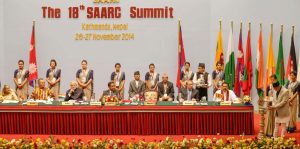The foreign ministers from the South Asian Association for Regional Cooperation (SAARC) participated in an informal meeting on the sidelines of the U.N. General Assembly on September 24 at a time when the grouping has struggled to remain functional. Since 2016, as India-Pakistan relations plummeted, India downgraded its SAARC participation with effect that the last summit of the grouping’s leaders was in 2014. However, the Narendra Modi government surprised analysts earlier this year when in March Modi participated in a SAARC leaders’ video conference. In that event Modi proposed the creation of an emergency fund to fight COVID-19; quite on-brand for initiatives that involve both India and Pakistan, the fund itself became a source of bickering for both countries.
Speaking at the meeting yesterday, Indian External Affairs Minister S. Jaishankar once again took aim at Pakistan, indirectly holding the country responsible for meager regional cooperation. An Indian foreign ministry statement notes that Jaishankar “called upon SAARC member states to collectively resolve to defeat the scourge of terrorism, including the forces that nurture, support and encourage an environment of terror and conflict, which impede the objective of SAARC to realize its full potential for collective collaboration and prosperity across South Asia,” a not very subtle dig at Pakistan.
Not to be outdone, his Pakistani counterpart Shah Mahmood Qureshi indirectly accused India of creating “artificial obstacles” in the way of SAARC functioning effectively. New Delhi pulled out of the 2016 summit which has going to held in Pakistan after a major terrorist attack on an Indian military base in Kashmir. “I would like to reiterate Pakistan’s willingness for hosting the 19th Saarc Summit at Islamabad at the earliest,” Qureshi said. Meanwhile others in the grouping — Afghanistan, Bangladesh, Bhutan, the Maldives, Nepal, and Sri Lanka – hoped that the India-Pakistan rivalry will not render SAARC permanently moribund, and that the meeting a modest step in the right direction. A Nepali official told the Kathmandu Post the “gesture was not toxic.”
South Asia remains one of the least economically integrated regions in the world, something SAARC, since its creation in 1985, has done very little to correct even as it continues to go through the motions. As India’s economy grew asymmetrically bigger than those of its neighbors, New Delhi has enthusiastically participated in groupings that reflect this newfound heft – such as the BRICS – even though China’s presence in that club roughly carries the same connotations as India’s in SAARC for others. At the same time and especially after Modi assumed office in 2014, India’s status-seeking foreign policy has sought to move away from groupings such as SAARC, the G-77, and the Non-Aligned Movement (implicitly considering them past their sell-by dates) and instead gravitated towards the G-20 and, increasingly, maritime Asia plurilaterals.
In fact, it was one such grouping, the Bay of Bengal Initiative for Multi-Sectoral Technical and Economic Cooperation (BIMSTEC), that was being billed as the next SAARC, and a key component of Modi’s “Act East” policy for outreach to Southeast Asia. Comprising of Bangladesh, Bhutan, India, Myanmar, Nepal, Sri Lanka and Thailand, BIMSTEC has failed to deliver meaningful results despite considerable hype. Part of why that is the case is the perennial question of India’s extant capabilities. India contributed a shrimpy 80 million rupees to the BIMSTEC Secretariat last year, and that was after an annual increase. In fact, India’s lackadaisical attitude towards concrete delivery on regional projects have rarely matched its “neighborhood first” policy pronouncements. For example, implementation of a 2015 Bhutan-Bangladesh-India-Nepal agreement around regional connectivity remains stalled.
But there are signs that India is tracing a full circle, and the Modi government is reaching out to the very groupings it had snubbed in the past. As Suhasini Haidar dryly pointed out, after skipping two in-person NAM summits, in 2016 and 2019, Modi participated in this year’s virtual summit, in May. And his SAARC outreach this year suggests that the grouping may still soldier on.
































